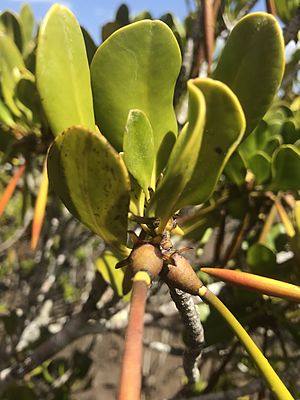Yellow mangrove facts for kids
Quick facts for kids Yellow mangrove |
|
|---|---|
| Conservation status | |
| Scientific classification | |
| Genus: |
Ceriops
|
| Species: |
australis
|
| Synonyms | |
|
|
The yellow mangrove, also known as Ceriops australis, is a special type of tree. It grows in salty water along coastlines. This mangrove belongs to the Rhizophoraceae plant family. You can find it in warm, tropical parts of northern Australia and southern New Guinea. It's quite common there. Even though many mangroves are in danger from things like habitat destruction and climate change, the yellow mangrove is doing okay. Experts say it is a "least concern" species. This means it is not currently at high risk of disappearing.
Contents
What Does the Yellow Mangrove Look Like?
The yellow mangrove is a small evergreen tree or shrub. It can grow up to about 10 meters (33 feet) tall. It often grows with many stems or a single strong trunk. It also has large roots that help support it.
Bark and Leaves
The bark of the yellow mangrove is usually silvery-grey. Sometimes it can be orangeish-brown. It feels smooth and has small spots called lenticels. The leaves grow in pairs opposite each other. They are shiny and yellowish-green on top. Each leaf is shaped like an oval and has smooth edges. They can be up to 6 centimeters (2.4 inches) long and 3 centimeters (1.2 inches) wide.
Flowers and Fruit
The flowers grow one by one where the leaves meet the stem. Each flower has a short cup-like part called a calyx. The flower parts usually come in groups of five or six. The fruit looks like a pear. It hangs from the small calyx. It starts brown and changes color as it gets older.
How it Reproduces: Viviparity
A special part of the fruit is called the hypocotyl. This is a long, thin, and smooth part that can grow up to 15 centimeters (5.9 inches) long. The yellow mangrove is viviparous. This means its seeds start growing while they are still attached to the parent tree. The young plant, called a propagule, comes out of the fruit. It then falls from the tree and grows into a new plant.
Yellow Mangrove vs. Spurred Mangrove
The yellow mangrove looks very much like another mangrove called Ceriops tagal. They often grow next to each other. For a long time, people thought they were the same species. But now we know they are different based on their genes. You can tell them apart when they have fruit. The Ceriops tagal has ribbed hypocotyls, but the yellow mangrove's hypocotyls are smooth.
Where Does the Yellow Mangrove Live?
In tropical northern Australia, the yellow mangrove is the main type of mangrove. It grows in areas where rivers meet the sea. You can find it from Exmouth in Western Australia all the way to Moreton Bay in Queensland. It also lives in New Guinea, but its exact range there is not as clear. This is because of the past confusion with Ceriops tagal.
Preferred Habitat
The yellow mangrove does not like strong waves or winds. It also avoids strong water currents. Instead, it prefers drier places. It likes areas with high salt levels. These are often found on the land side of the coastal mangrove strip. It also grows next to salt pans.
How People Use the Yellow Mangrove
Indigenous Australians have used this tree for many years. They traditionally made digging sticks and throwing sticks from its wood. They also used it for spear shafts. People used a special liquid made from the inner bark to help with skin problems. The outer bark was used to make dye and for tanning leather.
Animal Life
The larvae of a type of moth, called Syntherata janetta, eat the leaves of the yellow mangrove.



